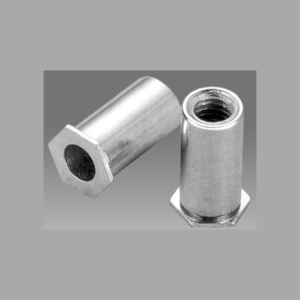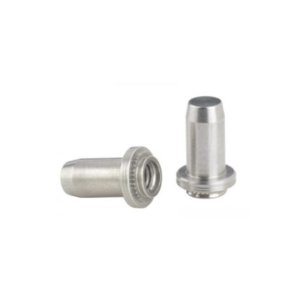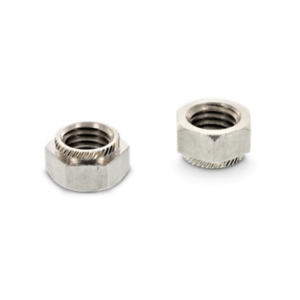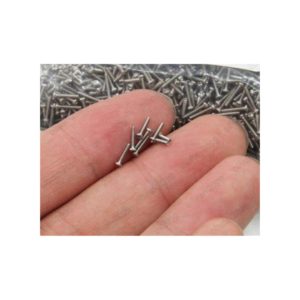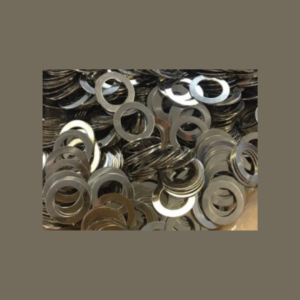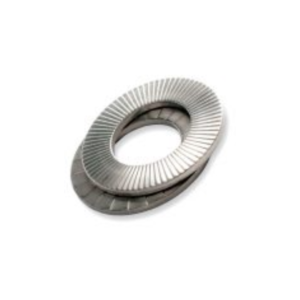Installation is simple, prepare the specified hole and using a flat punch and appropriate anvil, apply a parallel squeezing force to press the part into the hole. When installing in printed circuit board, broaching nuts are suitable for use in non-plated holes only.
-
Self Clinch Standoffs
A Self-Clinching Standoff provides an excellent solution for mounting, spacing and stacking of boards and panels.
They provide strong captivated reusable female threads in a spacer format in thin sheets.
Utilising a hexagon head and a clinch feature, this fastener has excellent torque-out, pull-through and push-out characteristics whilst providing a flush finish on the underside of the panel, requiring minimal surface finishing after installation.
They are installed using a parallel squeezing action, so require access to both sides of the panel.
Ease of assembly and quick removal are major reasons to specify Clinch Standoffs. They satisfy many functional and cosmetic requirements.
Threaded standoff bushes are an effective fastening element that serves as a spacer. A time-saving and simple assembly of workpieces, which have to be arranged at a certain distance from each other or parallel to each other, is made possible by this fastener.
They provide protection for fragile circuitry and electrical connections in printed circuit boards (PCBs) and other electrical assemblies. Self clinching standoffs eliminate the need for loose hardware on aftermarket components.
How Self Clinch Standoffs Work
Attached components are stacked on top of each other or distanced from the framework material by a standoff secured to a thin sheet metal chassis. These metal fasteners ensure safe grounding of electrical components and help reduce or eliminate hardware damage that can occur due to vibration and collision.
-
Self Clinching Studs
Self-Clinching fasteners provide strong load bearing male or female threads in thin steel and aluminium panels.
Installation is neat and easy.
Simply locate the fastener into a pre-prepared hole and apply a parallel squeezing force to embed the fastener into the panel.
Self-Clinching fasteners work by utilizing a special clinch feature.
When the part is pressed into the hole, the parent material cold-flows into the clinch feature, effectively locking the fastener into the panel, providing excellent torque-out and push-out performance.
Self-Clinching fasteners require a parallel squeezing force to be applied for correct installation.
Equally important is the length of time the force is applied. Sufficient time must be allowed for the cold-flow clinching process to work (this is often referred to as the dwell time when installing on a hydraulic press).
A self clinching stud is designed to become a permanent fixture of the part, component, or device onto which it’s installed. Installation is usually performed during the initial fabrication stage or in final assembly of the metal chassis. Parallel squeezing force is applied in order to secure the stud to the sheet metal panel.
For the best dimensional accuracy and performance, it is recommended that all holes in the sheet metal application be punched.
These externally threaded fasteners become permanently mounted to a metal framework, reducing costs and assembly time by eliminating the necessity for loose hardware and additional installation processes.
Self clinching studs are used for varying purposes, though all varieties are built to withstand high levels of torque, heavy weights, and constant, repeated pull by the attached components.
-
Self Clinching Blind Fastener
Self Clinching Blind Fasteners are used in applications requiring closed end threads.
Also known as clinching blind press nuts, they provide an excellent design solution for assemblies where there is a desire to protect the contents from foreign matter.
The blind press nuts can be installed into panels as thin 1.0mm. The configuration of the blind press nuts also limit the mating screw’s penetration into the assembly which can prevent any interference within the design.
This feature prevents any contact with the electronic circuitry in the design.
In contrast to the open version, the closed end self clinching nuts offer the advantage of a longer threaded part. The closed shank end seals the thread against external influences such as dirt, oil, moisture and protects against atmospheric corrosion.
In addition, their use is generally more cost-effective than comparable fasteners with similar sealing properties, which, however, require complicated seals and special assembly procedures.
Advantages
- Provide barrier against foreign matter
- Limits screw penetration thereby protecting internal components
- A sealing effect is achieved
These nuts provide a permanent blind thread in thin metal sheets.
The blind press nuts, along with providing the protection of shielding foreign matter from the design, and the mating screws penetration, they also eliminate the possibility of loose hardware.
The blind fastener encapsulates your threads, typically to prevent any foreign material from entering inside. Protrudes on one side of the sheet metal.
-
Flush Nuts
If you have a need for an industrial fastener that, after installation, will be completely flush with its surrounding surface, then the self-clinching flush nut should be your fastener of choice.
This type of insert nuts for flush insertion on both sides are flush with the top and bottom of the sheet metal.
These fasteners are ideal for applications where a thin sheet requires load-bearing threads but still must remain smooth, with no protrusions on either surface. This can provide strong threads in places which would be inaccessible for installation after chassis are formed.
Utilising a special proven clinch feature, this fastener has excellent torque-out and push-out characteristics whilst providing a flush finish on both sides of the panel. The hexagonal head ensures high axial and torsional strength.
Like all self clinching fasteners they are installed using a parallel squeezing action, so require access to both sides of the panel.
Advantages
- Ease of installation: All that is required to successfully install the nut is a simple parallel press device which can be used to push the flush nut into position.
- Suitable for use in thin metal: Provides a strong attachment in metal as thin as 1.6mm with a FLUSH finish.
- No hole preparation required: Eliminates the need for deburring or refinishing.
- Material suitability: Self-clinching flush nuts can be used in a wide variety of materials, including materials that are not conducive to welding.
- No secondary operations: Eliminates the need for additional tapping after installation.
- Insertion automation: Insertion process may be fully automated, thereby increasing process speed and reducing overall production costs.
- These Type F self-clinching nuts particularly can be installed flush before bending or forming operations get under way without risking potential interference problems that protruding fasteners could cause down the line.
Like all self-clinching fasteners they are installed using a parallel squeezing action, so require access to both sides of the panel.
Flush Nuts are available in various thread sizes, manufactured from 300 series stainless steel and are suitable for installation in ductile steel and aluminium panels with a recommended maximum hardness of 70 HRB
-
Press Nuts (Broaching Nuts)
Press nuts are used wherever a high degree of joint stability is required in thin-walled sheet metal or plastic parts. They are a very good alternative to nuts that are welded, brazed or welded to the component. Press nut that can obtain a high mounting strength thanks to the knurled portion under the neck.
Portion of the nut under the neck has a unique shape (knurled, grooved) and so a high mounting strength can be obtained.
Post-processing such as rust-proof processing, sputtering treatment for weld-on nuts, etc., not required.Broaching-type fasteners can be used on printed circuit boards as well as on many other types of brittle materials. They are often used on materials composed of glass laminate or epoxy bases. They are also designed for use on materials that are too thin to support adequate threading.
Broaching nuts, also known as PCB nuts due to being commonly applied in printed circuit boards, are designed with a knurled shank that can be pressed into the drilled hole. The shank grips the board with an interference fit by broaching its way into the panel as it is squeezed into the holes.
-
Clinch Nuts
The sheet metal surrounding the head cold flows into an undercut thereby making the fastener an integral part of the sheet.
Clinch Nuts can also be used instead of tapped holes for a more durable and stronger connection. Nuts, standoffs and studs can be used where it is not practical, or possible, to insert a fastener on both sides of a case.
For example, in an instance where there is a nut installed on the inside of an enclosure, you wouldn’t be able to hold a wrench to attach the cover, since the cover would interfere.
For the best dimensional accuracy we recommend that all holes in the sheet metal application be punched. To install the fastener into the punched Hole a profiled punch is required. It is essential that the recommended Hole tolerances be observed.
Self-Clinching Nuts provide strong reusable female threads in panels that are too thin to be conventionally tapped. Utilising a special proven clinch feature, this fastener has excellent torque-out and push-out characteristics whilst providing a flush finish on the underside of the panel.
Like all self clinching fasteners they are installed using a parallel squeezing force so require access to both sides of the panel.
-
MicroFast Nuts & Washers
To meet the growing needs of the industry, we have added MicroFast, a special range of micro size screws and nuts to our extensive list of products.
As products keep getting smaller and smaller, there is a real need to have very small screws and nuts to connect a number of mini components.
This range provides a solution to the many industries that need reliable fixing options in the Micro range.
Mobile Phones, Sensors, Electronics, Laboratory equipment etc.
Micro Nuts
Small Size nuts from M1.0x0.25 and UNC2-56 onward
Micro Washers
Micro Washers from M1.2 onwards.
Micro Nuts and Washers are now possible with Black coating on special order
-
Retaining Washers
Retaining Washers feature internal fins, which grip the thread of a fasteners, creating a self-retaining fastening. Retaining Washers are designed for use with Captive. The combination of Captive Screw and Retaining Washer creates a lightweight and cost-effective locking solution for safety applications.
A Plastic Retaining Washer is primarily used to hold screws and bolts in place during assembly and have a design that grips the outside of screw or bolt shank. Also known as an Anti Loss Washer, they provide insulation, cushioning and spacing. They help insulate fastening assemblies from moisture and electricity.
This washer range includes options with internal and external teeth with a tapered design. The washer slides/assembles on to the screw (or bolt) and is retained by the screw once assembled. The washer cold forms and fully enters the pitch of the screw to provide sealing.
These washers allow for preliminary mounting of the screw (or bolt) before securing with a nut. They are ideal when pre-assembly of the screw and washer is required.
-
Safety & Conical Spring Washers
These are used for locking a device and reducing the vibration. They reduce loosening by preventing unscrewing rotation of the fastening device; locking washers are usually also spring washers.
Washers are available in a wide range such as spring washers, star washers, multi-tooth washers, disc spring washers, wave washers, taper washers, safety washers etc.
Serrated Safety Washers Type S – Schnorr Type
The Safety Washers are of trapezoidal cross section and serrated on both sides. The security is achieved through friction and mechanical locking.Advantages- The cross section ensures locking effect at the outside diameter.
- Due to the closed ring form, high degree of pretensioning is achieved.
- Sliding surfaces allow tightening with damaging the mating surfaces.
- High resistance to vibration due to positive locking of the serrations
- Suitable for a wide range of screw/bolt heads minimizing stocks.
-
Disc and Conical Spring Washers
These are used for locking a device and reducing the vibration. They reduce loosening by preventing unscrewing rotation of the fastening device; locking washers are usually also spring washers.
Washers are available in a wide range such as spring washers, star washers, multi-tooth washers, disc spring washers, wave washers, taper washers, safety washers etc.
Conical Spring Washers
DIN 6796
A Conical spring washer designed to help prevent loosening of bolted joints under vibration. This type, manufactured to DIN 6796 has an inherent conical shape. It is also known as a Belleville washer, disc spring, coned-disc spring and cupped disc washer.

